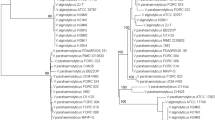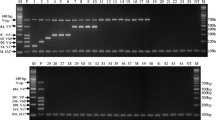Abstract
Vibrio anguillarum is a major pathogenic bacterium that causes vibriosis and septicemia in fish and shellfish. In this study, we identified the groESL genes, which encode bacterial chaperonins, from V. anguillarum. The groE gene cluster consisted of a 291-bp groES gene, a 69-bp intergenic spacer region, and a 1,635-bp groEL gene order. Sequence analysis with the groESL gene of Vibrio species exhibited that the groEL gene was more species-specific and suitable than the groES gene for V. anguillarum detection. Owing to the difficulty in distinguishing V. anguillarum from the closely related V. ordalii, we compared the sequences of groEL from V. anguillarum and the groEL homolog hsp60 from V. ordalii, in order to design a primer set based on a region dissimilar between the two. PCR with the groEL primer set produced a clear 195-bp amplicon in six serotypes of V. anguillarum, whereas 23 Vibrio species of 39 samples, including V. ordalii, and 10 species of enteric bacteria gave no bands. PCR using the groEL primers also amplified a unique product from V. anguillarum-infected flounder and oyster tissues. These results demonstrate that the groEL-target PCR assay is a sensitive and species-specific tool for the detection of V. anguillarum infection.






Similar content being viewed by others
References
Austin B, Austin DA (1999) Characteristics of the pathogens. Bacterial pathogens: diseases of farmed and wild fish, 3rd edn. Praxis, London
Denkin SM, Nelson DR (2004) Regulation of Vibrio anguillarum empA metalloprotease expression and its role in virulence. Appl Environ Microbiol 70:4193–4204
Peeler JT, Houghtby GA, Rainosek AP (1992) The most probable number technique. In: Downes FP, Ito K (eds) Compendium of methods for the microbiological examination of food. American Public Health Association, Washington DC, pp 105–120
Kaysner CA, DePaola AJ (2001) Vibrio. In: Downes FP, Ito K (eds) Compendium of methods for the microbiological examination of food. American Public Health Association, Washington DC, pp 405–420
Skov MN, Pedersen K, Larsen JL (1995) Comparison of pulsed-field gel electrophoresis, ribotypying, and plasmid profiling for typing of Vibrio anguillarum serovar O1. Appl Environ Microbiol 61:1540–1545
Martinez-Picado J, Alsina M, Blanch AR, Cerda M, Jofre J (1996) Species-specific detection of Vibrio anguillarum in marine aquaculture environments by selective culture and DNA hybridization. Appl Environ Microbiol 62:443–449
Austin B, Austin DA, Blanch AR (1997) A comparison of methods for the typing of fish-pathogenic Vibrio spp. Syst Appl Micrbiol 20:89–101
Thompson CC, Thomson FL, Vandemeulebroecke K, Hoste B, Dawyndt P, Swings J (2004) Use of recA as an alternative phylogenetic marker in the family Vibrionaceae. Int J Syst Evol Microbiol 54:919–924
Dorsch M, Lane D, Stackebrandt E (1992) Towards a phylogeny of the genus Vibrio based on 16S rRNA sequences. Int J Syst Bacteriol 42:58–63
Kita-Tsukamoto K, Oyaizu H, Nanba K, Simidu U (1993) Phylogenetic relationships of marine bacteria, mainly members of the family Vibrionaceae, determined on the basis of 16S rRNA sequences. Int J Syst Bacteriol 43:8–19
Urakawa H, Kita-Tsukamoto K, Ohwada K (1997) 16S rDNA genotyping using PCR/RFLP (restriction fragment length polymorphism) analysis among the family Vibrionaceae. FEMS Microbiol Lett 152:125–135
Gonzalez SF, Osorio CR, Santos Y (2003) Development of a PCR-based method for the detection of Listonella anguillarum in fish tissue and blood samples. Dis Aquat Org 55:109–115
Hirono I, Masuda T, Aoki T (1996) Cloning and detection of the hemolysin gene of Vibrio anguillarum. Microb Pathog 21:173–182
Rodkhum C, Hirono I, Crosa JH, Aoki T (2006) Multiplex PCR for simultaneous detection of five virulence hemolysin genes in Vibrio anguillarum. J Microbiol Methods 65:612–618
Xiao P, Mo ZL, Mao YX, Wang CL, Zou YX, Li J (2009) Detection of Vibiro anguillarum by PCR amplification of the empA gene. J Fish Dis 32:293–296
Hong GE, Kim DG, Bae JY, Ahn SH, Bae SC, Kong IS (2007) Species-specific PCR detection of the fish pathogen, Vibrio anguillarum, using the amiB gene, which encodes N-acetylmuramoyl-l-alanine amidase. FEMS Microbiol Lett 269:201–206
Kim DG, Bae JY, Hong GE, Min MG, Kim JK, Kong IS (2008) Application of the rpoS gene for the detection of Vibrio anguillarum in flounder and prawn by polymerase chain reaction. J Fish Dis 31:639–647
Zügel U, Kaufmann SHE (1999) Role of heat shock proteins in protection from and pathogenesis of infectious diseases. Clin Microbiol Rev 12:19–39
Susin MF, Baldini RL, Gueiros-Filho F, Gomes SL (2006) GroES/GroEL and DnaK/DnaJ have distinct roles in stress responses and during cell cycle progression in Caulobacter crescentus. J Bacteriol 188:8044–8053
Craig EA, Gambill BD, Nelson RJ (1993) Heat-shock proteins; molecular chaperones of protein biogenesis. Microbiol Rev 57:402–414
Parsell DA, Lindquist S (1993) The function of heat-shock proteins in stress tolerance; degradation and reactivation of damaged proteins. Annu Rev Genet 27:437–496
Garduńo RA, Faulkner G, Trevors MA, Vats N, Hoffman PS (1998) Immunolocalization of Hsp60 in Legionella pneumophila. J Bacteriol 180:505–513
Sagane Y, Hasegawa K, Mutoh S, Kouguchi H, Suzuki T, Sunagawa H, Nakagawa T, Kamaguchi A, Okasaki S, Nakayama K, Watanabe T, Oguma K, Ohyama T (2003) Molecular characterization of GroES and GroEL homologues from Clostridium botulinum. J Protein Chem 22:99–108
Musatovova O, Dhandayuthapani S, Baseman JB (2006) Transcriptional heat shock response in the smallest known self-replicating cell, Mycoplasma genitalium. J Bacteriol 188:2845–2855
Mutharia LM, Klinck J, Yamaguchi H, Davey M (1998) Purification, characterization and immunochemical properties of a novel 60-kDa protein of Vibrio anguillarum strains. FEMS Microbiol Lett 168:111–117
Kuchanny-Ardigò D, Lipińska B (2003) Cloning and characterization of the groE heat-shock operon of the marine bacterium Vibrio harveyi. Microbiology 149:1483–1492
Yamauchi S, Okuyama H, Morita EH, Hayashi H (2003) Gene structure and transcriptional regulation specific to the groESL operon from the psychrophilic bacterium Colwellia maris. Arch Microbiol 180:272–278
Callison JA, Battisti JM, Sappington KN, Smitherman LS, Minnick MF (2005) Characterization and expression analysis of the groESL operon of Bartonella bacilliformis. Gene 359:53–62
Aravindhan V, Christy AJ, Roy S, Ajitkumar P, Narayanan PR, Narayanan S (2009) Mycobacterium tuberculosis groE promoter controls the expression of the bicistronic groESL1 operon and shows differential regulation under stress conditions. FEMS Microbiol Lett 292:42–49
Sanders BM, Martin LS (1993) Stress proteins as biomarkers of contaminant exposure in archived environmental samples. Sci Total Environ 139–140:459–470
Ryan JA, Hightower LE (1996) Stress proteins as molecular biomarkers for environmental toxicology. EXS 77:411–424
Ait-Aissa S, Porche J, Arrigo A, Lambre C (2000) Activation of the hsp70 promoter by environmental inorganic and organic chemicals; relationships with cytotoxicity and lipophilicity. Toxicol 145:147–157
Kwork AYC, Wilson JT, Coulthart M, Ng L, Mutharia L, Chow AW (2002) Phylogenetic study and identification of human pathogenic Vibrio species based on partial hsp60 gene sequences. Can J Microbiol 48:903–910
Sambrook J, Russell DW (2001) Molecular cloning. In: A laboratory manual, 3rd edn. Cold Spring Harbor Laboratory, Cold Spring Harbor, NY
Ausubel FM, Brent R, Kingston RE, Moore DD, Smith JG, Seidman JG, Struhl K (1987) Current protocols in molecular biology. Wiley, New York
Tsai J, Hsueh P, Lin H, Chang H, Ho S, Teng L (2005) Identification of clinically relevant Enterococcus species by direct sequencing of groES and spacer region. J Clin Microbiol 43:235–241
Acknowledgments
This research was supported by a project grant (YSG-RE0701) from Yeongnam Sea Grant, Korea.
Author information
Authors and Affiliations
Corresponding author
Rights and permissions
About this article
Cite this article
Kim, DG., Kim, YR., Kim, EY. et al. Isolation of the groESL cluster from Vibrio anguillarum and PCR detection targeting groEL gene. Fish Sci 76, 803–810 (2010). https://doi.org/10.1007/s12562-010-0266-y
Received:
Accepted:
Published:
Issue Date:
DOI: https://doi.org/10.1007/s12562-010-0266-y




